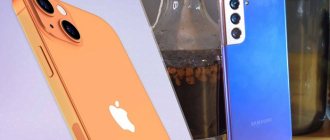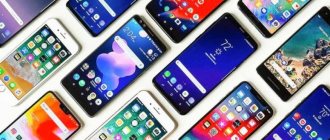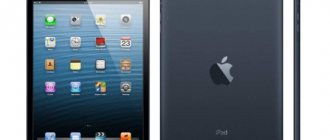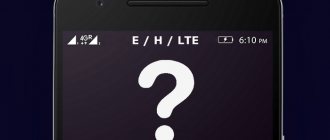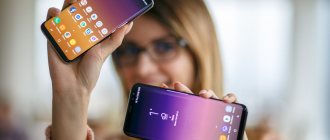At first glance, everything is quite simple. The company's current product lines are represented by the following series:
- M
- A
- S
- Note
The Z Flip and Fold phones can be considered separately.
Many users roughly understand the positioning: S and Note are premium gadgets, Z Flip and Fold are experimental, with flexible screens, A is the middle segment, M are budget devices. But if we consider the individual models within each series and their cost, it turns out that the logic of such a division does not work. How to figure it out and what to buy in the end?
Classification of smartphones from Samsung
When studying new products and ranking them, we will focus on the following classification of smartphone market segments - it is conditional, because not all models can be clearly placed in it, but it is convenient for practical use:
- Line
M. This segment includes low and mid-price models. Their main quality is high autonomy. Almost all devices in this line have batteries of at least 5500-6000 mAh, which ensure a long operating time without recharging. The line does not offer powerful processors and cameras, but is suitable for those consumers who need a simple and reliable device for long-term communications - Line
A. We will include mid- and high-price solutions. They are equipped with screens made using Amoled and Super Amoled technologies. - Line
S. These are already flagships. They are equipped with the most advanced chips and the most powerful Qualcomm processors. The same applies to cameras, sensors and other devices.
Additionally, the Note
– it can be considered as the S segment for business. It includes flagship-class smartphones, but intended primarily for businessmen. The 20th model of this class is expected to be released, but at the time of writing this review it had not yet appeared on the smartphone market.
How to choose a smartphone from Samsung?
Before moving on to a review of specific models, let's talk a little about what the consumer should pay attention to. When choosing a device, you should take into account not only the price, but also the parameters of the smartphone: sometimes only 1-2 thousand rubles turn out to be decisive, and at a slightly higher price you will get a model of a fundamentally different class.
The consumer should consider the following:
- Screen
. The South Korean corporation produces them either on IPS matrices or based on AMOLED technology in Super or Dynamic versions (premium models). There is no fundamental difference: Samsung in any case guarantees that the brightness, contrast and color rendition will be at the proper level. However, for those who for some reason desperately need maximum parameters, it is worth taking models with Infinity screens: for 2022, this is a technological peak in terms of density and frame rate. - Processors
. The company uses either its own developments or Snapdragon models (400 to 800 series). The most powerful chips for 2022 are the Snapdragon 865 and the purely Samsung flagship Exynos 990. - Cameras
. It’s worth noting here that this is Samsung’s strong point: even mid-range and frankly budget models are equipped with 3 and 4 sensors. As for resolution, for “state employees” the standard for the main lens is 48 Megapixels (MP), in the middle level there is a 64 MP matrix. For the most advanced models, Samsung offers an option with a 108-megapixel main sensor and a 64-megapixel auxiliary sensor - and its competitors don’t have anything close to that. With such a sensor system, the smartphone's capabilities approach some of the parameters of professional digital cameras, while remaining within the dimensions of a pocket device. - Battery life
. Here we must honestly admit: you have to pay for performance, an ultra-clear screen and numerous functions - and the payment is precisely the operating time without recharging. Alas, modern equipment eats up battery power like Carlson eats up strawberry jam. Nevertheless, modern smartphones have a charge from 15 to 40 W, and new processors (especially 7-nm ones) are still more economical than their predecessors. - Memory
. The minimum here for the M segment will be 3-4 GB of RAM and about 64 GB of ROM - at the level of an average desktop computer 5-8 years ago. More advanced models have larger volumes - up to 12 GB for flagship devices.
REFERENCE
: Frankly speaking, this amount of memory for a smartphone is not even excessive - these are prohibitive parameters for solving any conceivable tasks for 2022 (no one is going to render 3D video with special effects for a Hollywood blockbuster on a pocket device?). However, Samsung knows what it is doing: if memory is not particularly needed today, this does not mean that it will not be needed tomorrow - they still remember the famous phrase that no computing device needs more than 640 KB, allegedly said by Bill Gates himself in 1981? So, to paraphrase the military saying about cartridges, there is either very little RAM, or not enough, but you can’t put in more.
What do the s, e, Lite and Plus markings mean?
One more thing, as Samsung's competitors like to say. If you look through the Samsung catalog, you will more than once come across modifications of popular models with additional set-top boxes, for example, Samsung Galaxy S10e 128 GB Price from UAH 19,999 to 14,250 or Samsung Galaxy M30s 64 GB. Let’s immediately say that there is no clear logic behind these letters; Samsung is now actively experimenting with inexpensive handsets, so there’s no need to bother too much. If you go up a level, you will often find Pro and Lite consoles. They make much more sense: Lite means a simplified version of the flagship, Pro - on the contrary, an improved one, with more powerful hardware and a larger screen. Now that you know all this, we can move on to reviews of the current Samsung lines.
Year of issue
- NU/N/Q*N – 2022
- Q/MU/M – 2022
- KS/KU – 2016
- JS/JU – 2015
- HU/H – 2014
- F – 2013
- E – 2012
- D – 2011
- Since – 2010
- B – 2009
- A – 2008
The letters Q and N have been chosen for 2022. "Q" is used to represent high-end "QLED" TVs. "N" denotes regular LCD models.
Additional letters were also added to those that represent the year:
- S – TVs under the “SUHD” brand (produced in 2015 and 2016);
- U – ultra-high resolution 4K UHD screen.
All Q (QLED) and S (SUHD) models have 4K UHD resolution (3840x2160).
Previously, the following letter was also found (after the designation of the year): H - means a body of normal thickness;
If there are no other letters in the marking after the year designation letter, but the series immediately appears, then this means a regular LED HDTV TV with Full HD (1920x1080) or HD Ready (1366x768) resolution.
TV series
The following numbers indicate the series and subseries of Samsung TVs.
The first denotes the series itself - these are numbers from 4 to 9. The most expensive and technically advanced are the 9 series television receivers.
As the series descends, the price decreases and the technical characteristics deteriorate, or more precisely, the devices become simpler, without additional functions.
The second number indicates the podcast series. According to some experts, various technical data may be hidden in this figure. There is no official explanation from the company regarding this figure, so it is difficult to say for sure.
The third number relates to design, so it will not reveal any technical parameters.
Tuner
The fourth digit indicates the presence of a tuner and its type. For example, the number 7 meant the presence of a DVB-T2 tuner, and 0 meant the presence of a DVB-T tuner. This was the case until 2013, but since 2013, the type of tuner began to be designated by two letters, and the fourth number also began to refer to the design.
Now the type of tuner is designated as follows (a newer designation is indicated in brackets):
- AW (W) - DVB-T/C tuner;
- AB (B,AU or U) - DVB-T2/C/S2 tuner;
- AK (K) - DVB-T2/C tuner;
- AT (T) - two tuners 2 x DVB-T2/C/S2;
- SB - DVB-T2/C/S2 tuner;
- SS - DVB-T/C/S2 tuner;
- ST - two tuners 2 x DVB-T2/C/S2;
- SL - two tuners 2 x DVB-T/C/S2;
- AF (BF) - DTV Tuner/Digital Cable Tuner/Analog Tuner;
- DK - DVB-T2/C;
- AR (DR) - DTV Tuner/Analog Tuner.
Destination country designation
And the last are three letters that indicate the country in which this TV will be sold:
- XRU - Russia;
- XUA - Ukraine;
- XCS - Kazakhstan;
- XZF - France;
- XXU - England;
- XZТ - Italy;
- XXC - Spain;
- XZA - USA;
- XXY - Australia;
- XMA (XXM) - Malaysia;
- XZN - Arab countries;
- XXT - India, Thailand;
- XMS - Asia;
- XZG - Germany, Austria and Switzerland;
- XXN - Belgium, Holland, Luxembourg;
- XBT - Baltic (Lithuania, Latvia, Estonia);
- XXE - Norway, Sweden, Denmark, Finland;
- XXH - Eastern Europe (Slovakia, Hungary, Poland and so on).
J Series – Economy Class Smartphones
This line includes entry-level gadgets costing from six to 10 thousand rubles. These are modest and practical workhorses in plastic cases.
The processors are 4-core, with 1 or 2 GB of RAM, suitable for performing everyday tasks and running games that are not demanding on hardware. There is not much pre-installed memory - around 16 GB, but the storage in many models can be overclocked to 256 or 512 GB.
Screens use inexpensive IPS or TN matrices with HD or HD+ resolution. Considering the budget models, you can’t count on frameless displays.
As a rule, J-series smartphones receive a modest set of photo modules from a single main and front camera with a resolution of no more than 13 and 5 megapixels, respectively. There are usually no problems with daytime photography, but at night the pictures will turn out blurry. Naturally, smartphones do not provide AI support.
However, in reissues of the most popular models, the manufacturer puts more advanced components in smartphones. Due to this, the demand for J line gadgets is still high. Thus, Samsung Galaxy J2 2022 is one of the best-selling gadgets in 2022. The model has an energy-efficient five-inch Super AMOLED screen with a resolution of 960 x 540 pixels. The quad-core Qualcomm Snapdragon 425 chipset does a good job of running multiple applications. The 8 megapixel camera allows you to take clear pictures in the daytime. A modest-sized 2600 mAh battery provides up to 14 hours of video viewing, up to 60 hours of audio playback, up to 11 hours of browsing the Internet when connected to Wi-Fi, and up to 10 hours of working on 3G networks.
Samsung Galaxy J
The J series is in demand due to the following properties:
- low cost;
- advanced cameras with a sufficient choice of settings, high-quality pictures with a selfie lens;
- the ability to choose a smartphone for a child or an elderly person, with a minimum set of unnecessary options;
- wide variety of phones.
This line is popular among young people and people who use a smartphone for basic functions, without storing and processing a large number of files.
We understand the line of Samsung Galaxy A-series smartphones
What do we associate large smartphone manufacturers with? Of course, with flagship devices. We say Samsung - we think about Galaxy S, we think about Apple - of course, in the context of the iPhone Pro Max, etc. We usually associate the middle segment with other companies, and to correct this, Samsung launched a separate Galaxy A line several years ago. Its key goal was to offer users affordable devices with a good price/quality ratio in order to compete with Chinese brands. Now there are many different smartphones in this line - let's figure out what the letters and numbers in the model names mean.
The newest devices end in one. These are models that came out at the end of 2022 and the beginning of 2022, these include the A01, A51 and A71. The devices from the first half of 2022 end with zero - these are the Galaxy A10, A20, A30 and A40 models. Back in the second half of 2022, devices with the “s” index were introduced, this is an expansion of the previous model range. This includes the Samsung Galaxy A20s and A30s.
The first number after “A” means “coolness” and premium quality of the device, so the most affordable and budget models start with “0” or “1” (for example, A01 or A10), and the top smartphones from the line have the numbers “5” and “ 7" (for example, Galaxy A51 and A71). Well, we’ve sorted out the notations, let’s move on to the models themselves.
Samsung Galaxy A01 and A10
Galaxy A01 is the most affordable model in the line and can please you with a large display, sufficient RAM and internal memory, a dual camera and, of course, an excellent price. This is a typical average for undemanding users.
The Galaxy A10 costs a little more, but has a significantly larger display diagonal, twice the internal memory and slightly increased battery capacity.
Both devices are aimed at those who want to buy a device from Samsung, but are not ready to spend a lot of money on it.
Samsung Galaxy A20s and A20
These smartphones are for those who like to spend a lot of time looking at the display and who value a large diagonal and long operating time. It’s convenient to go on long trips with them or just while away the time on the subway or train. You know for sure that they won't run out thanks to the large battery, and you won't have to strain your eyes because the display size is simply phenomenal. The A20s has a slightly better camera, but the A20 runs on a more powerful chipset and, with the same battery capacity, is lighter and thinner, otherwise the models are very similar.
Samsung Galaxy A30s and A30
Both models have a lot in common; the manufacturer just focused on different characteristics. So in the A30s, more attention was paid to cameras, and the A30 has a much better display, more RAM and internal memory, and also has support for fast charging. Both devices are an excellent solution for those who are looking for devices with a good price/quality ratio.
Galaxy A50: model with screen scanner and triple camera
Starting with the Galaxy A50, the Samsung Galaxy A 2019 smartphones rise to a whole new level. First, let's list the most fundamental differences:
- More powerful hardware (Exynos 9610 or Snapdragon).
- The fingerprint scanner is on the screen.
- Triple camera: standard + wide-angle module + depth sensor.
The Galaxy A50 smartphone is built on the 10 nm Exynos 9610 hardware platform . Powerful Cortex-A73 cores operate at a higher frequency (2.3 GHz), and there are four of them, not two, as is the case with the previously mentioned Exynos 7884/85. The transition to a 10 nm process technology provides qualitative improvements in terms of performance while reducing power consumption.
The camera is already triple . The resolution of the main module is 25 megapixels (in previous models the maximum resolution was 16 megapixels). The wide-angle camera is built on a sensor with a resolution of 8 megapixels. The third module is represented by a depth sensor with a resolution of 5 megapixels.
The battery is still 4000 mAh . There is fast charging, the power supply is 15 watts . Compared to the Galaxy A30, the screen characteristics have not changed - 6.4-inch , resolution 2340 by 1080 pixels, Super AMOLED matrix. The front camera resolution is 25 megapixels , like in the Galaxy A40.
| CPU | Exynos 9610, 10 nm |
| Memory | 4/64, 6/128 GB |
| Screen | 6.4, Super AMOLED, 1080 x 2340 |
| Battery | 4000 mAh |
| Fast charging | 15 watt |
| Camera | 25 MP, F/1.7, 28 mm 8 MP, F/2.2, 12mm 5 MP, F/2.2 |
| Frontal | 25 MP, F/2.0 |
| Fingerprint scanner | on the screen |
| USB | Type-C |
| NFC | There is |
What to remember? Starting with the Galaxy A50, all models of the Galaxy A 2022 line are equipped with a triple rear camera with a standard, wide-angle and depth sensor. The fingerprint scanner in the A50, A70 and A80 is integrated into the display.
Samsung Galaxy A51
This smartphone would definitely be considered a victory for Samsung... if the Chinese Xiaomi had not counterattacked by releasing the MI A3 model with comparable parameters, but at a much lower price (let’s note in passing that watching the “battle of the titans” in the smartphone market is exciting, and the result of the competition here is clear is for the benefit of the consumer). Be that as it may, 51 Galaxy from Samsung also has advantages:
- original (one might even say extravagant) design, definitely memorable and eye-catching;
- In some respects, the Samsung smartphone is head and shoulders above.
These parameters, in particular, include a camera with a 32 megapixel matrix. In addition, the A51 also has a fingerprint scanner - not always useful, but definitely an original device. The camera itself includes 3 photomodules:
- 48 MP;
- 12 MP;
- at 5 MP.
The basis of the device is a Samsung processor with 8 cores Exynos 9611. It is complemented by a Mali-G72 MP3 graphics accelerator. As for energy supply, the model is equipped with a 15 W fast charging system. Additionally there is an NFC module.
Advantages:
- possibility of shooting in Ultra HD 4K;
- fast charging system;
- reading papillary lines on fingers;
- very powerful hardware.
Flaws:
- after all, a 48 megapixel sensor is not 64 megapixels, like many other budget models. It’s even strange that the corporation used this particular matrix.
Samsung Galaxy A71
In terms of price-quality ratio, Samsung has no competition for this device in 2020. 6.7-inch screen with Super AMOLED matrix technology and a resolution of 2400x180? Pixel density 393 ppi? Are you joking? Did you make a smartphone or a pocket cinema? And at such a low price?!
Design is also “something with something”. The specialists did their best, and this smartphone looks very memorable.
As for the camera, one front selfie camera already has a resolution of 32 megapixels - many previous models do not have this on the main sensor. And the main one includes 4 modules with a 64 MP main sensor. As a result, you can take photos and videos with quality up to 3840x2160 ppi.
The hardware basis is a pair of the “draconian” chip of the Snapdragon 730 model (and this is already the flagship level) and the Adreno 618 video accelerator.
As for energy supply, the model supports fast charging at 25 W.
Advantage:
- screen with Super AMOLED matrix;
- high resolution front camera;
- original design and appearance;
- excellent sound even without headphones, exclusively with the speakers of the smartphone itself;
- 25 W fast charging.
Flaws:
- Absent in principle. Something of better quality can only be obtained in the flagship class at completely different prices.
Classification of Samsung phones by letter
Samsung Galaxy smartphones are divided into several lines - these are the A, S, Z, M, Note series and others.
Each letter corresponds to its own category of gadgets. Some experts believe that the letters in the names of phone models correspond to words.
For example,
✓Galaxy S stands for “Super” or “Smart”, that is, “super” or “smart”.
✓ Galaxy Note is a “Note” or “Note”, as you like.
✓ Galaxy A comes from the word “Alpha” - Alpha, that is, “first”.
✓ Galaxy M is the first letter of the word “Magical”, that is, “magical” or “Millennial”, that is, “millennium”.
Phones of such series as J (joy), Y (young), W (wonder), R (Royal or Refined) were also produced.
However, other experts believe that the letter names of the episodes do not correspond to the words.
“They are necessary to differentiate the lines, and do not carry any semantic load,” Vladimir Gritsenko, an expert on the NAFI “Digital Citizen” platform, told the Prime agency.
However, the letters help classify Samsung phones by parameters.
Flexible screens – Galaxy Fold and Galaxy Z Flip
About a year ago, Samsung showed the first smartphone with a flexible screen – the Galaxy Fold. This device became a pioneer in a new category of devices for the entire market, a kind of pioneer. The compact folding body houses a large screen that creates a hybrid smartphone and tablet. Nothing like this had ever existed before, and this is the first commercial smartphone with such capabilities.
The lack of competitors, a completely new niche and high cost instantly turned the Galaxy Fold into a hero among fashion smartphones; there is simply not a single production model on the market that would be sold in such volumes. And competitors were unable to establish mass production in the absence of their own flexible screen technologies.
Due to its size, the device is perceived as masculine, which is what it is. And this is not bad, since for the first time a model has appeared for those who are willing to spend 180 thousand rubles on a smartphone and do not consider this a high price. This is a price for status and technology.
Flip phones disappeared for a while, only to return in the form of the Galaxy Z Flip, which is perceived as a great smartphone for women. It also has a flexible screen, but the body colors and appearance – all this gives away the device as a female model. It turns out that the Galaxy Fold is for him, and the Z Flip is for her.
In the absence of even remote analogues to such a model as the Z Flip, it instantly became popular; at a cost of 120 thousand rubles, it is also an image model. The fairer sex loves bright, unusual things, and the Z Flip is no exception. When a girl wants to stand out and at the same time get not just a toy, but a smartphone at the flagship level, then this is almost the only option.
Smartphones with flexible screens are a combination of advanced technology and image, the latter cannot exist without technological innovation. And smartphones with flexible screens have both. But their cost is such that it is impossible to call such models a mass segment; these are not millions of buyers, like other series of smartphones from Samsung. Such devices can safely be called exclusive, accessible to a few.
S Series - advanced flagships
Advanced technologies and materials, protection from dust and moisture - this is about the S line, which includes exclusively top-end flagships. The price tag is appropriate - from 30 thousand rubles. New models of the line appear, as a rule, once a year under the same number in two or three versions: basic, lightweight and advanced. Diagonals, dimensions, chipsets, cameras change. One thing remains unchanged: each device is unique, setting development vectors for competitors. So, in the S8 the manufacturer used a curved widescreen screen, in the S9 it installed a camera with a variable aperture. However, both models are still on sale. Thanks to the reduction in prices, smartphones are relevant for purchase.
In 2022, the series celebrates its 10th anniversary. For the sake of this event, the brand brought to the market its most advanced creation in three numbered versions: Samsung Galaxy S10, S10e and S10 Plus.
In order for the Super AMOLED display to occupy the maximum area of the front panel, a hole was drilled directly in the screen for the front camera (and in the S10 Plus it is double). In addition, the engineers removed the external speaker, making it under-screen. The S10 and S10 Plus models also have a fingerprint scanner under the screen.
Dual and triple cameras of gadgets not only recognize the scene, but also indicate to the user frame defects such as a blocked horizon. The proprietary 8-core chipset is responsible for high performance in gadgets. And the battery supports reverse wireless charging: smartphones are not only charged in Wireless mode, but also transmit energy themselves through their cases.
Galaxy S10 Plus
We will start the rating of flagship models of 2022 from Samsung with the Galaxy S10 Plus. This model has a screen increased in size to 6.4 inches. Also, compared to the old and now classic version of this device, the new smartphone has a proprietary Exynos 9820 chip with 8 cores and a clock frequency of up to 2.7 GHz. Particular attention should be paid to the camera. The front has a special cutout made using laser technology. The main one has quite sophisticated optics - a telephoto lens, a wide-angle lens, a variable aperture, etc.
In fact, in a smartphone form factor, you get a professional camera capable of shooting high-quality 4K video. As for photographs, we can talk about a professional level without any discounts - in fact, the quality of the photo now depends only on the user’s skills: the smartphone’s camera leaves nothing to be desired and provides every opportunity for high-quality photography. It is also worth paying attention to fast charging and a 4100 mAh battery.
Advantages:
- long autonomy;
- high quality camera;
- unique smartphone design;
- screen of the highest resolution and quality;
- excellent sound reproduction.
Flaws:
- incomplete Russification: Bixby is not in Russian and is not expected.
Galaxy S20
Users who desperately need an excellent camera should turn their attention to this device.
Although this model is a flagship model, it is inferior to Note10+ in a number of parameters. However, working with photo and video images is the strong point of this model. The screen frequency is 120 Hz, the camera functionality is everything for businessmen who do not like to save money and want to get not only a smartphone for their money, but also a camera for amateur photography with professional quality.
The device supports 2 nano-SIM and nano+e-SIM. The hardware is based on two main processors:
- Exynos 990.
- Snapdragon 865 is a more powerful, but also rarer configuration.
The screen has a resolution of 3200x1440 with a density of 563 ppi – you couldn’t ask for anything better for a pocket device. There are practically no stronger devices on the market. At the same time, the RAM reserve of 12 GB allows you to perform almost any imaginable task. What to do with so much memory is up to the owner to decide.
Advantages:
- high processor power;
- excellent sound even without special headphones;
- camera of the highest quality;
- high shooting frequency;
- excellent stabilization;
- original and stylish appearance of the device.
Flaws:
- price. Even for its capabilities, the device is expensive.
Samsung Galaxy S6
The Galaxy S6 was announced in March 2015. Most of the characteristics have undergone significant changes. The design has changed and the body is made entirely of metal. For the first time in the last few years, the company decided to release its flagship only on its Exynos 7420 processor. As before, it consists of two sets of cores with the same frequencies as the previous model, but the type of cores is different - Cortex-A57 and Cortex-A53 are used .
RAM was increased to 3 GB. They abandoned the memory card slot, but increased the internal memory capacity to 32, 64 or 128 GB, depending on the modification. The screen size and manufacturing technology remain the same. Increased resolution and pixel density (Quad HD, 557 dpi). Android 5.0.2 was initially installed.
In the summer of the same year, the Samsung Galaxy S6 Edge+ was introduced. Unlike the simple Galaxy S6, it has 4 GB of RAM and a 5.7-inch display. Its design features rounded edges and a glass back surface. Unfortunately, the company refused to protect its smartphones from dust and moisture.
Samsung Galaxy S7
The Galaxy S7 appeared on the Russian market in February 2016. Externally, it is not very different from the Galaxy S6, but the internal content has improved significantly and allows the smartphone to claim the title of the best device released at the beginning of the year.
The new product is equipped with the Exynos 8890 chipset, which has Exynos M1 cores also produced by the company itself. According to the test results, the processor shows high performance among other smartphone processors currently available on the market. Work with single-threaded computing has been improved, since not all modern applications can use multiple cores at once. Some markets will have the Galaxy S7 with the Qualcomm Snapdragon 820 chipset, which has 4 Kryo cores with frequencies of 2.15 and 1.6 GHz. RAM is 4 GB, and internal memory is 32 or 64 GB.
A slot for removable memory media with a capacity of up to 200 GB has been returned to the Galaxy S line. The number of megapixels in the main camera was reduced to 12, but the shooting quality was much improved, especially in low light. The screen size and resolution remain the same. The smartphone comes with Android 6.0 Marshmallow OS and the updated TouchWiz shell.
Galaxy S9
Naturally, the wave of success that covered Samsung was expected, then they released the S9 in which they did not introduce anything new, but only slightly changed the back panel of the device and, naturally, installed more modern and serious components.
That is, the company continued to follow a two-year cycle of major upgrades for its flagships. They roll out innovations, the next year they simply refine them, and then, in the third year, they roll out innovations again.
This happened with the Galaxy S9, which still has a lot of users.
The point was precisely that this was a landmark device - from it Samsung emerged as the undisputed market leader and everyone tried to imitate them, everyone began to slowly move away from the Apple cult...
But the crown is heavy and it is necessary to maintain the title of leader, so the company tried and introduced a completely new product!
Galaxy S20 Ultra
And finally, a mobile device that can be called the best smartphone from Samsung as of 2022. This model sets several records in terms of characteristics:
- Camera with 108 and 64 megapixel sensors.
- The front camera is 40 megapixels – for many budget models this is the resolution of the main camera.
- 6.9-inch Dynamic AMOLED display. It has a resolution of 3200x1440 and supports HDR10+. The refresh rate reaches 120 Hz.
- The Exynos 990 processor is, if not the most powerful of mobile chips, then clearly in the top five.
- RAM 12 GB.
- 100x magnification - nothing like this on other smartphones.
The device, among other things, gives the user the ability to shoot video in 8K format.
Advantages:
- the most powerful camera system in terms of quality and resolution;
- excellent display;
- the most productive processor;
- more than decent amount of RAM.
Flaws:
- no significant ones were identified.
Samsung Galaxy S3
May 2012 was marked by the release of the next smartphone in the Galaxy S line. Samsung Galaxy S3, iPhone 5 and Lumia 920 became the three best smartphones of the year. In addition to improved technical performance, the phone has new Smart Stay technology.
Its essence is to preserve the display brightness settings and not block the smartphone when the front camera captures the user’s gaze directed at the display. Technologies have been added to control a smartphone by voice, a vibration signal if the user picks up the phone with missed calls, recognizing people in photos and searching for matches among friends on social networks and several other functions.
All modifications are powered by a 4-core Exynos 4 processor with a frequency of 1.4 GHz, with the exception of a device released specifically for the USA, based on a Qualcomm Snapdragon S4 with 2 cores. In addition to the standard set of functions, the 8-megapixel rear camera takes a series of 20 pictures in auto mode, and can also select the best frame among 8. Video shooting in Full HD format is available. The front camera has a resolution of 1.9 MP and shoots smaller format (HD) videos.
The display size was increased to 4.8” and returned to SuperAMOLED and Gorilla Glass protective glass, but a more modern second version. The screen resolution was 720p, the pixel density was 306 pixels per inch. Modifications differ in the size of internal memory: 16, 32 or 64 GB, RAM is the same for all and is equal to 1 GB.
By the beginning of 2013, Samsung had sold 40 million units. A version of the Galaxy S III mini was released with a 4-inch screen, a dual-core 1 GHz processor and cameras with a resolution of 5 and 0.3 MP.
Samsung Galaxy S5
Traditionally, a new Galaxy S5 model was released at the beginning of 2014. Changes have been made to the design, performance and camera. The highlight was the addition of a fingerprint scanner and a heart rate sensor. An additional bonus was that the smartphone complies with the IP67 certificate (dust and moisture protection).
As before, phones with a Qualcomm Snapdragon 801 processor (4 cores, 2.5 GHz) or an Exynos 5422 (4 cores with a frequency of 2.1 GHz plus 4 cores with a frequency of 1.5 GHz) are presented for different markets. The RAM remains the same, there are only two memory options left - 16 or 32 GB, supported removable memory media can have a capacity of up to 128 GB.
The screen has increased slightly to 5.1 inches, the resolution has not changed, and the pixel density has decreased by 9 pixels. The main 16-megapixel camera can shoot video in the new Ultra HD format, and the 2.1-megapixel front camera can shoot video in Full HD format. Initially, Android 4.4.2 was installed on the Galaxy S5, and later updates to version 5 of Lollipop became available.
Example of decoding markings
Let's look at two models from different years and with different display matrices. The following describes all possible variations of marking.
2016 model with LED screen
Let's look at one example of Samsung TV labeling. From left to right:
- U - LED TV,
- E - region Europe,
- 75 - screen diagonal in inches,
- K - 2016 model,
- 9 is the ninth series, the numbers 0,0,0 won’t tell us anything without the help of specialists (the last two zeros talk about design),
- AB - indicates the type of tuner, which can be determined in the list below.
2022 model with QLED screen
Another example of Samsung TV designation, already for the Q model:
- Q - QLED TV,
- E - region Europe,
- 65 - screen diagonal in inches,
- Q9 is a 9-series model,
- F - flat screen (for curved ones the letter C),
- A - date of release and start of sales,
- M - the letter refers to design,
- U - tuner type,
- XRU is the country of destination Russia.
Screen view
The first letter indicates the screen manufacturing technology:
- U - illumination of the LCD matrix with LEDs (LED - Light-Emitting diode);
- Q – QLED, LCD matrix using quantum dots for backlighting, Quantum dot enhancement film (QDEF);
All modern Samsung TV models use liquid crystal matrices (LCD) as a display; the backlight of the matrix and the quality of the matrix itself differ. That's why there are regular U models and premium Q TVs.
Not released today:
- K - matrices of organic light-emitting diodes (OLED - Organic Light-Emitting Diode);
- P - plasma screen (PDP - Plasma Display Panel), discontinued in 2014;
- L — matrix illumination with fluorescent lamps (CCFL — Cold Cathode Fluorescent Lamp), not available since 2013;
- C - kinescope (CRT - Cathode Ray Tube), not produced today.
Screen Shape:
- F – flat screen (flat);
- C – curved screen (curved);
Continent
The second letter indicates the distribution area (for whom it is made):
- E – Europe;
- A - Asia, Africa, Australia;
- S – Iran;
- N - Korea, North and South America.
Screen size
TV receivers are usually produced with screens from 32 inches to 65 inches, the most popular among users. There are also larger screens, but these are for larger rooms and most buyers do not choose them.
Note series – stylus included
The flagship Note line stands apart among letter series. Its key feature is the presence of an electronic Bluetooth pen, the S Pen. The stylus significantly expands the control capabilities of your smartphone in terms of work and creativity.
Thus, in the Samsung Galaxy Note 9, you can use the stylus to control photography and video playback, write notes, switch slides and draw colorful illustrations. And if a 6.4-inch diagonal is not enough, the smartphone can be connected to a TV or computer screen.
The filling in the model is, naturally, top-notch. The gadget runs on a powerful 8-core Samsung Exynos 9810 chipset, there is support for memory cards up to 1 TB, the dual main camera has a variable aperture, and the 4000 mAh battery capacity is enough for about a day of work in mixed mode. In addition to durable Gorilla Glass 5, the smartphone boasts an IP68 standard - it does not tolerate dust or immersion in water.
Let's summarize. In order not to get confused in the letter designations of the series, just remember:
J are entry-level budget models. Suitable for the first acquaintance with the world of mobile technologies, without being confusing with the abundance of advanced functions.
A – average price category. Smartphones have low price tags and up-to-date hardware.
S – premium gadgets. They use the very best – from case materials to intelligent algorithms.
Note is for creative people who need a powerful device with a large display and a stylus.
Note
A family of phablets equipped with proprietary S Pen styluses. By choosing the Note, users get a device with top-end specifications, at least among the Galaxy, and software that takes advantage of the large display - for example, running two apps on one screen. The presentation of new representatives of the line takes place every year at IFA in Berlin.
How much does Samsung S21 cost?
RUB 68,990 RUB 74,990 + 739 bonuses Program Organizer: Svyaznoy Network LLC (OGRN 1057748288850,
Interesting materials:
How to log in as an administrator on Windows 10? How to enter Windows 10 Safe Mode at boot? How to enter Device Manager on Windows 7? How to log into a guest account in Windows 7? How to enter Windows 10 recovery menu on boot? How to log into mail on Windows 10? How to sign into a Microsoft account on Windows 7? How to log into Windows 10 without a password? How to log into Windows 10 without an account? How to restore a user on Windows 10?
